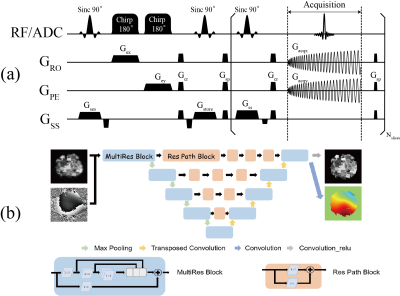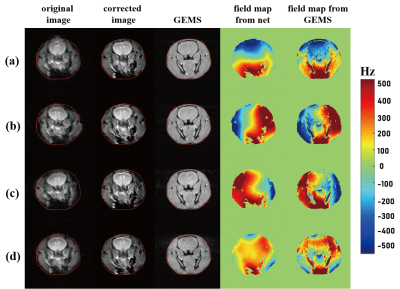3600
Deep learning-based referenceless distortion correction for single-shot non-Cartesian spatiotemporally encoded MRI1Xiamen University, Xiamen, China
Synopsis
Non-Cartesian spatiotemporally encoded MRI sequence shows obvious advantages in spatial Non-Cartesian spatiotemporally encoded MRI sequence shows obvious advantages in spatial selectivity and sampling efficiency. However, the resulting image is susceptible to severe distortion due to the cumulative effect of the B0 field inhomogeneity. In this work, this issue is addressed by introducing a deep learning-based method that is specifically tailored to inhomogeneous field correction. Simulation and in vivo rat brain experiments show that our method can effectively correct the image distortion and obtain the field map without extra reference scan.
Introduction
The spatiotemporally encoded (SPEN) MRI introduces quadratic phase modulation by the use of frequency-swept pulse, which enables spatially selective acquisition and reduced field of view imaging.1-3 Spiral sampling is a non-Cartesian sampling method that uses a continuous oscillating gradient, which can improve the sampling efficiency, reduce the difficulty of gradient switching, and decrease the occurrence of eddy current effects. However, one disadvantage of SPEN spiral sampling is that the B0 field inhomogeneity effect will accumulate along the sampling trajectory, causing a large distortion around the periphery of the image. Traditional distortion correction needs extra scans and is sensitive to object motion or field fluctuation. To tackle this problem, referenceless distortion correction is of necessity, which is difficult because of the absence of B0 information. In previous work, low-order polynomials were used to characterize inhomogeneous field, followed with the iterative algorithm for distortion correction.4 Such method needs no extra acquisition and can prevent introducing motion artifacts. The correction efficacy, however, is still limited as a result of low-order assumption of inhomogeneous field. In this work, we present a deep learning-based distortion correction algorithm to achieve fast and referenceless correction for multi-slice non-Cartesian SPEN MRI.Methods
The multi-slice non-Cartesian SPEN sequence we designed is shown in Figure 1(a). When B0 field inhomogeneity exists, the actual sampling trajectory will deviate from the predetermined trajectory. The image obtained by super-resolved reconstruction according to the predetermined trajectory can be severely distorted. For SPEN sequence, the movement of the stable phase point represents the movement of the sampling point, that is, the actual sampling trajectory containing the information of the field inhomogeneity is reflected in the super-resolved reconstructed image. The neural network can be employed to learn the information of inhomogeneous field from the distorted images.For deep learning-based reconstruction method, it is crucial to have a large amount of qualified training data. However, real training samples are difficult to obtain since the label acquired under ideal magnetic field is not available and it is also difficult to produce all sorts of inhomogeneous fields. Therefore, synthetic training samples were adopted by simulating various random inhomogeneous fields, which included not only global field variation but also local field disparity. Through MRiLab simulated software,5 a large number of distorted simulated samples acquired by non-Cartesian SPEN sequence were obtained. The numerical model of M0 was a random combination of geometrical shapes.6 The T1 relaxation, T2 relaxation, and diffusion were ignored for simplicity.
The network structure is shown in Figure 1(b), in which we chose the amplitude and phase map of the distorted image as the input of the network, while the numerical model of M0 and the field map as the label. The MultiResUNet7 was used to extract the feature of the inhomogeneous field to achieve correction. We verify the feasibility of our method through simulation and rat brain experiments.
Results
The corrected results of the simulation and rat brain experiments are shown in Figures 2 and 3. For clarity, only the results of one slice are shown. The original images suffer from geometric distortion, aliasing of signals and blurring of edges due to the B0 field inhomogeneity. Our method can effectively correct both the distortion and blurring of the original images. In the simulation, the corrected image is close to the numerical model of M0 while the obtained field map is close to the numerical model of the field map. In the rat brain experiments, we use the field map and the shape of images acquired by GEMS as reference considering its robustness to the field inhomogeneity. The proposed method not only effectively corrects the distortion caused by inhomogeneous field along different directions, but also obtains field maps quite close to the ones from GEMS. Simultaneously, the correction algorithm significantly reduces background noise. These results verify the effectiveness of our method. The correction does not require any extra acquisition, and the whole process only takes a few hundred milliseconds.Discussion
We use a neural network to learn the information of the B0 field inhomogeneity from the amplitude and phase maps for multi-slice non-Cartesian SPEN image correction. Deep learning has powerful nonlinear fitting capability and no need of predefined parameters. It is fast and can extract local field features that are otherwise difficult to retrieve in iterative algorithms. And it does not need to increase the sampling time, which further avoids introducing motion artifacts.Conclusion
Compared with Cartesian SPEN sequence, non-Cartesian SPEN sequence has the power of flexible reduced FOV imaging and higher acquisition efficiency, but it loses the strong power of resisting distortion caused by inhomogeneous field. The deep learning-based referenceless correction scheme we proposed can quickly and effectively correct such distortion. This method has good potential in correcting the images of body parts such as the abdomen where both strong B0 field inhomogeneity and motion exist.Acknowledgements
This work was supported by the National Natural Science Foundation of China under grant numbers U1805261, 11761141010 and 81671674.References
1. Li J, Chen L, Cai SH, et al. Imaging with referenceless distortion correction and flexible regions of interest using single-shot biaxial spatiotemporally encoded MRI. Neuroimage, 2015;105:93-111.
2. Liberman G, Frydman L. Reducing SAR requirements in multislice volumetric single-shot spatiotemporal MRI by two-dimensional RF pulses. Magn. Reson. Med., 2017;77(5):1959-1965.
3. Cousin SF, Liberman G, Solomon E, et al. A regularized reconstruction pipeline for high-definition diffusion MRI in challenging regions incorporating a per-shot image correction. Magn. Reson. Med., 2019;82:1322-1330.
4. Chen L, Huang JP, Zhang T, et al. Variable density sampling and non-Cartesian super-resolved reconstruction for spatiotemporally encoded single-shot MRI. J. Magn. Reson., 2016;272:1-9.
5. Liu F, Velikina JV, Block WF, et al. Fast Realistic MRI Simulations Based on Generalized Multi-Pool Exchange Tissue Model. IEEE Trans. Med. Imaging, 2017;36:527-537.
6. Cai CB, Wang C, Zeng YQ, et al. Single-shot T2 mapping using overlapping-echo detachment planar imaging and a deep convolutional neural network. Magn. Reson. Med., 2018;80:2202-2214.
7. Ibtehaz N, Rahman MS. MultiResUNet: Rethinking the U-Net architecture for multimodal biomedical image segmentation. Neural Networks, 2020;121:74-87.
Figures


